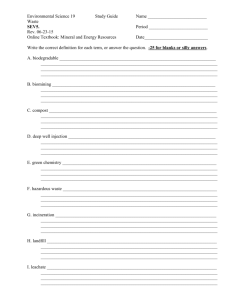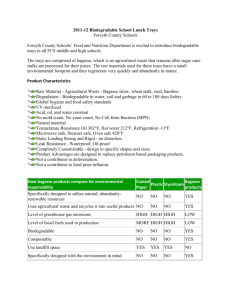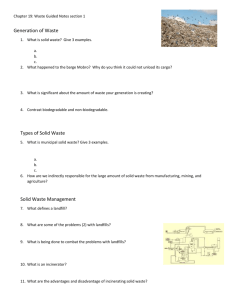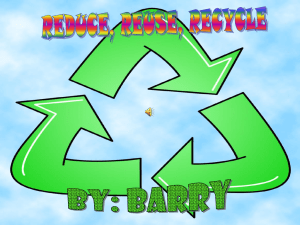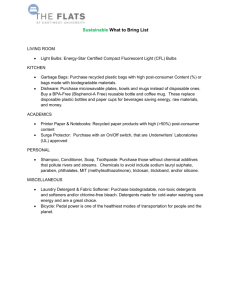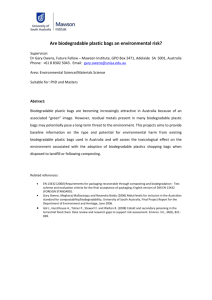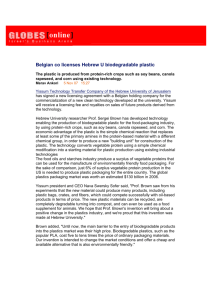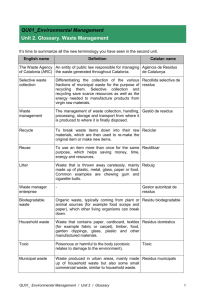At the end of day at many conferences or events,
advertisement
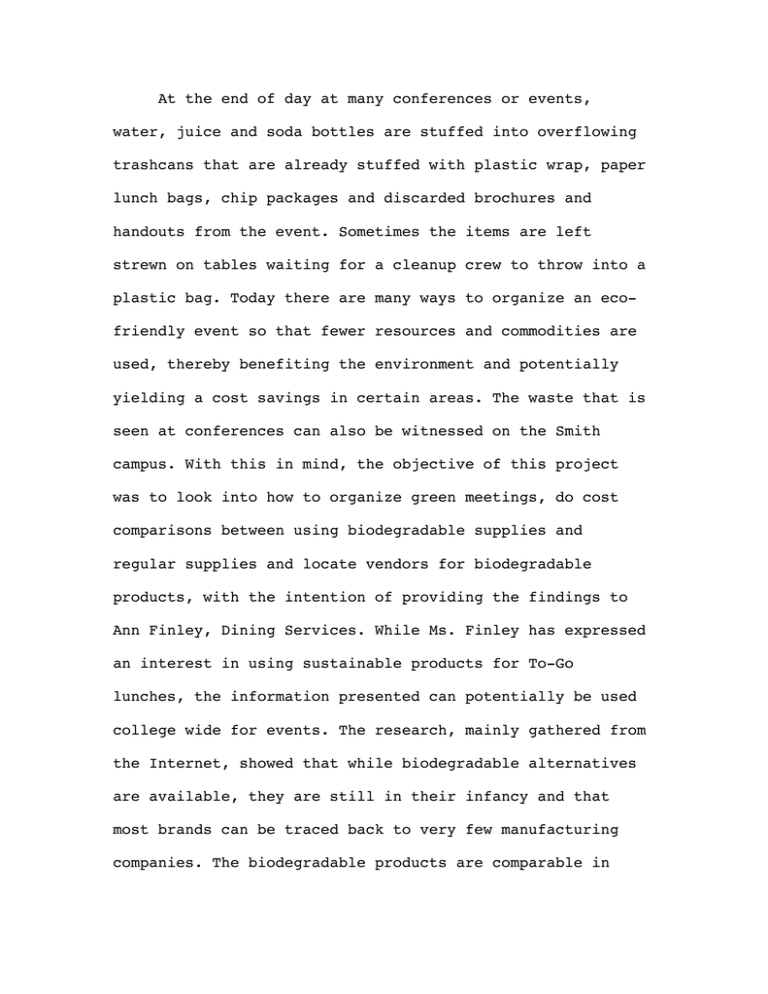
At the end of day at many conferences or events, water, juice and soda bottles are stuffed into overflowing trashcans that are already stuffed with plastic wrap, paper lunch bags, chip packages and discarded brochures and handouts from the event. Sometimes the items are left strewn on tables waiting for a cleanup crew to throw into a plastic bag. Today there are many ways to organize an ecofriendly event so that fewer resources and commodities are used, thereby benefiting the environment and potentially yielding a cost savings in certain areas. The waste that is seen at conferences can also be witnessed on the Smith campus. With this in mind, the objective of this project was to look into how to organize green meetings, do cost comparisons between using biodegradable supplies and regular supplies and locate vendors for biodegradable products, with the intention of providing the findings to Ann Finley, Dining Services. While Ms. Finley has expressed an interest in using sustainable products for To-Go lunches, the information presented can potentially be used college wide for events. The research, mainly gathered from the Internet, showed that while biodegradable alternatives are available, they are still in their infancy and that most brands can be traced back to very few manufacturing companies. The biodegradable products are comparable in price for some items but show a discrepancy for other items. When comparing cost alone, plastics were always less expensive than biodegradable items. The vision for this project was to assemble green meeting basics, to focus on the availability of biodegradable dining wares and to determine the practicality of using them for To-Go lunches, in particular. Disposable plastic negatively impacts the environment because of landfill usage and of toxic byproducts from the manufacturing process. Because green meeting guidelines and biodegradable alternatives are still relatively new, information for this report is from websites and interviews. A search of WorldCat and Amazon did not find books about green or sustainable event, meeting or conference planning. Using renewable resources instead of non-renewable resources at events and take away meals reduces the effect of toxic emission from the manufacturing and incinerating of non-renewable products and of eliminating them from landfills. Furthermore, factories have less hazardous waste for disposal. The greatest benefit of using non-petroleum based products could be that the USA reliance on foreign oil would be reduced. An advantage of using biochemicals that extends beyond the reduction of the undesirable consequences of petroleumbased products is the enhancement that can happen to the economy of depressed areas in the heartland. Crops that are needed to produce recyclable materials are cumbersome to transport and store, so factories are built in rural areas where the crops are grown (sustainablebusiness.com). Farmers in these areas could be benefited by billions of dollars in revenue due to the AgVision 2020 program that has a goal for “plants to become the source of 10% of chemical feedstock by 2020” (sustainablebusiness.com) to make products including plastic. Every year the United States disposes of approximately “60 billion cups, 20 billion eating utensils and 25 billion plates”, (Bradford, Cain, Drumm, Hay, 2003) all nonrenewable dining wares that are useful to have available for the on-the-go lifestyle of Americans. If this waste were biodegradable, it could become fertile compost instead of taking up existing landfill space and requiring new space to be created. Establishing new landfills requires “complex steps to minimize negative impact of the environment” (Marisson, Sano, Ueta 2004) and uses space that could serve building or agricultural purposes. One hundred years ago most products were made from plant matter; by the 1980s, petroleum almost replaced biological materials (sustainablebusiness.com). Now, due to high petroleum prices, better technology for making plant base products and government support, dining products are again being made with plants such as corn, sugar and bamboo. Now after an event, these products can be combined with food waste, put in a bioplastic bag and sent to a compost facility (sustainablebusiness.com). According to the Convention Industry Council, a green meeting or event incorporates environmental considerations to minimize its negative impact on the environment. Additional benefits of a green event can be financial savings. The case study in the Appendix shows some costs savings, compiled by Meeting Strategies Worldwide (MSW). From the 2002 Forest Leadership Forum green conference that was attended by 1,300 participants, MSW found that online registration saved $3,900 in paper, printing and postage, that not providing conference bags saved $11,700 and that not providing handouts saved $1,950. Using water in pitchers instead of plastic bottles saved $12,187, and serving condiments in bulk rather than packages saved 62% on cream and 50% on sugar. The biggest savings, $30,00 $40,000 was due to choosing hotels close to the Convention Center, thereby eliminating the need for buses. The total green savings from the conference was more than $60,000 (Spatrisano and Wilson, 2003). The closest the US comes to having a set of standards for planning a green event is the Convention Industry Council’s Green Meeting Report. In 2003, a Council’s task force established best practices to be used as guidelines of sustainability in meeting planning. The guidelines are divided into supplier and organizer sections and deal with matters such as accommodations, location, transportation, meals, communication, marketing and education. In addition to the CIC report, there are other guides such as the EPA’s It’s Easy being Green, BlueGreen Meetings, the National Recycling Coalition’s Green Meetings Policy, and the Canadian “Green” Meeting Guide. MSW has some steps to consider for planning a green event. After gaining the support of the leadership of the conference by highlighting the environmental benefits, potential cost saving and the “look good” image of hosting a green event, Step 1 is to identify environmental priorities and measures that can be put in place to accomplish those objectives in an economically feasible way. At this stage, policies and expectations should be detailed to eventually communicate to all parties expected to be involved – vendors, the facility and the attendees. Step 2 is to establish a respectful relationship with the facility and vendors and to identify areas of environmental improvement that can fit the budget of both. The policies and expectations that were established in Step 1 can now be communicated to the facility and vendors. The third step is to assure success by carefully working with and checking the facility and each vendor to make sure there is follow through of expectations. Step 4 looks at ways to measure success of an event. A survey is a way to measure how successful the participants consider the event to be. The list below of best practices for greening an event can be used to figure out the reduction of environmental impact in a quantifiable way. Step 5 is where parties should evaluate and share lessons learned from the event. Below is a list of many best practices for planning a green event. Environmentally Responsible Planning Measures Recommended by Amy Spatrisano and Nancy Wilson of Meeting Strategies Worldwide in Greening a Global Conference: Lessons for the Future unless otherwise noted as EPA It’s Easy Being Green, BG (Blue Green Meetings) or C (Canadian “Green” Meeting Guide) Basic Operations • Communicate via e-mail rather than traditional mail or memos. • Use an online registration system. • Make two-sided copies. • Use recycled paper. • • • • • Do not hand out a conference bag. If you must have a bag, make sure it is constructed of recycled materials or cloth. Use recyclable nametag holders. EPA Use non-toxic markers. C Signage should be reusable. C Place cards and banners should be reusable or made from recycled materials. C Marketing Materials • Print on recycled paper with vegetable or soy based ink. • Publish the registration brochure online only. At most, send a postcard with the date steering attendees to a Web site. • Limit speaker handouts to materials on request. • Ask participants to use their own pens and paper but provide some for those who forget. C Food and Beverage • Serve items such as cream, sugar, mustard and ketchup in bulk containers. • Provide water in pitchers or large bottled water stations instead of individual bottles. • Donate consumable items to a local food bank. • Use local and sustainable food products. • Implement recycling of glass, plastic, metal and paper and encourage use with signs and announcements. • Use cloth instead of paper napkins and paper tablecloths and cutlery instead of plastic utensils. Otherwise, use biodegradable items. • Serve smoothies instead of packaged snacks. • Eliminate the use of disposable items, especially Styrofoam, plastic straws and coffee stirrers. • Provide reusable mugs for coffee and water. EPA • Serve bite size breakfast snacks and fresh fruit on small reusable plates. EPA • Discard food waste in a warm composting bin. EPA • Do a careful head count of attendees to reduce preparation of meals. EPA • Allow delegates to pre-select their meal sizes beforehand. BG • Choose centerpieces and decorations that can be reused such as living plants or silk flowers. Give then away as table prizes. BG Meeting Location • Choose a hotel within walking distance of the convention center. • Eliminate shuttles. • Educate attendees about public transportation and walking routes. • Find naturally lighted meeting and exhibit spaces. EPA • Facility Management • Turn off lights, equipment and air conditioning while not in rooms. • When practical, use natural cooking, ceiling fans, curtains and blinds. C In order to find out more about planning a green event, I talked to one of the principals, Amy Spatrisano, of Meeting Strategies Worldwide, a green conference management company in Oregon. Ms. Spatrisano emphasized the tremendous and unfortunate impact that large conferences have on the environment. She mentioned that even though green event planning has been happening since the late 1980s, the momentum for hosting green events has only begun to accelerate in the past year and a half. In part, she believes that this has to do with messages of global warming and high oil prices that are increasingly in the media. Ms. Spatrisano said the biggest challenge that green events planners face is expelling the myth that executing a green event is too hard or too expensive to do. Lessons she has learned have been the importance of being emphatic with venue management and vendors about the greening of a meeting from the start, of the need to carefully monitor progress, and of allowing enough time for ordering supplies and making changes to arrangements, if need be. In addition, participants in the event should be educated on a website, in pre-registration and program materials, and in announcements at the meeting about the event being green, and they should be encouraged to recycle in containers that are provided. In recent years, several biodegradable and recyclable food and beverage products, that can be used when hosting a sustainable event, have become available. These products, as an alternative to petroleum based plastics, are attracting the attention of a few colleges, such as Middlebury, which has begun to incorporate some of these supplies into their dining services. Currently, Middlebury is using cornstarch cutlery and cups for beer and wine and bamboo-reed plates. Their experience with the cornstarch spoons has been that they become limp if left in a bowl of soup too long. I questioned the concern that cornstarch products could create an allergic reaction in someone who has a corn allergy. There have been no known incidents of any reaction at Middlebury. Figure 1 describes types of biodegradable food and beverage products that are now available. PLA (polylactic acid) is made in the USA by Cargill Dow from glucose, mainly corn, and can be used with food that is less than 110 degrees. The products are clear and look like plastic made from petroleum. Bagasse is made from sugar cane fiber that is bleached with hydrogen peroxide to make it white. Bagasse products are oil resistant, can be used with all temperatures of food and liquid and can be microwaved or put in a freezer. Earthshell is another white, hot-cold product, presently used to make plates and bowls, which are made from limestone and vegetable starches. It is similar to Styrofoam but is biodegradable. Chinet Naturals is made into plates and bowls from the pulp of defective milk cartons. They are unbleached, microwave and freezer save, oil resistant and made in the USA. Cellophane is a storage packaging material made from cellulose of trees and plants. Like Bagasse and Chinet, it is oil resistant and can be microwaved and used in a freezer (recyclaholics.com). Biograde is a hot and cold product made from cellulose and limestone. (biodegradablestore.com) The various types of products take between 30 and 120 days to decompose. PLA takes 30 – 45 days, Bagasse takes 45 – 60 days, Cereplast less than 60 days and BioGrade 90 – 120 days. See the Appendix for a picture of a cup as it biodegrades. When I tested the durability of some biodegradable utensils, the results were that the corn fork immediately became very soft and lost its structure in hot water while the cellulose/limestone fork bent only slightly in hot water and returned to its original shape when removed from the hot water. Spoons of the same materials did not change in any way in lukewarm or cold water. While it was quite possible to find biodegradable, compostable food and beverage serving products on the Internet, the task of finding biodegradable, recyclable food packaging was fruitless. At one point, Earthshell produced a wrap for hot and cold sandwiches. When I called Earthshell to price their hinged lid sandwich and salad container, I was told they no longer produce the containers or the wrap. The person I spoke with could not explain why. My search for biodegradable packaging at Whole Foods yielded nothing. According to Ms. Spatrisano, the reason for this is that the FDA has not allowed recycled waste, such as newspaper and magazine that have been touched by consumers, to be used in food packaging. This postconsumer material can only be used for items such as paper towels and napkins. Recycled waste, such as mill scraps, that have not been touched by the consumer (preconsumer) can be used in hot cups and plates and bowls. Only recently has the FDA allowed a breakthrough in their restrictions. After eight years of research and testing, Starbucks was finally allowed to introduce a 10% postconsumer recycled hot cup in March 2006 (greenbiz.com). According to greenbiz.com, this cup is expected to reduce the “company’s dependence of tree fiber annually by more than five million pounds” (greenbiz.com). It is a food industry first and a milestone. Further savings from using 10% postconsumer Starbuck cups can be seen in Figure 2. A cost comparison among biodegradable products and with petroleum-based products can be seen in Figure 3. For all the biodegradable products that were compared to plastic products, 7-inch plates, 12 oz. cups and flatware were at least twice as costly as plastic and, in the case of cutlery, were four to six times more expensive than the products from HPC Food Services. Biodegradable, hinged clamshells were less expensive than biodegradable To Go containers with lids. Most of the prices for biodegradable products were close to one another regardless of the supplier. An exception was the rectangular container with a lid that was about one third less at mansfieldpaper.com than at biodegradablestore.com. When comparing costs of plastic products versus biodegradable products, the cost of disposal of non-biodegradable products must be factored in. While there were several different suppliers of products, I presented two or three with the best prices for each item. Except for the rectangular container, mansfieldpaper.com had the best prices, and biodegradablestore.com was next. Mansfield Paper is in Springfield and biodegradablestore.com is in Colorado, so shipping costs should be less from Springfield, and fewer resources would be used for transportation as well as less greenhouse gases emitted. While numbers can be gathered from some websites about the cost savings of green planning, Smith should run their own numbers for a scenario. The first step would be to identify and price biodegradable products at sites like mansfieldpaper.com and biodegradablestore.com. Next the number of non-biodegradable products currently being purchased at Smith should be determined. The cost for the same amount of biodegradable and non-biodegradable products should be computed to find the annual cost of buying each item. The freight charges of each potential order should be determined from the suppliers or by figuring the mileage between suppliers and Smith and multiplying a factor that could include the price of gas and other trucking expenses. Lastly, disposal prices for waste would need to be factored into the total cost of using biodegradable and nonbiodegradable dining wares. Though still in its early stage, green event planning is happening more often, and there are new and more products appearing on the market to make these events sustainable. A goal for society is to have the green meeting guidelines become the norm for all conference and event plans. In addition, colleges and universities can use the same strategies and products to make a positive impact on the environment. REFERENCES According to Mary Koncel of the Jacobson Center, when citing references for individual products, it should be acceptable to provide the site for the main products page that will make it possible to easily find all of the products for the entire website. This is what I have done. Barchard, W. Wayne. (1995). “Green” Meeting Guide. http://www.ns.ec.gc.ca/greenman/manual/greenpdf.pdf Biette, Matthew. Director, Dining Services. Phone interview. Middlebury College. Spring 2006. Biodegradablestore.com. http://biodegradablestore.com Biodegradablestore.com. Biograde Forks. http://biodegradablestore.com/pp/Utensils/bio/pp_bio_fork_C &P.html Bluegreenmeetings.org. Blue Green Meeting Hosts and Planners. http://www.bluegreenmeetings.org/HostsAndPlanners/index.htm Bradford, C., Cain, M., Drumm, M., Hay, S. (2003) Biodegradable Alternatives for Styrofoam and Plastic. Environment and Resources Studies, WATgreen project. http://www.adm.uwaterloo.ca/infowast/watgreen/projects/libr ary/f03biodegradeablesatstjeromes.pdf Convention Industry Council’s Green Meeting Report. April 6, 2004. http://www.conventionindustry.org/projects/green_meetings_r eport.pdf Environmentaldefense.org. (Posted April 27, 2006) Starbucks Paper Project. http://www.environmentaldefense.org/article.cfm?contentid=7 91 Environmental Protection Agency. (1996). It’s Easy Being Green! http://www.epa.gov/epaoswer/non-hw/reduce/grn-mtgs/gmbklt.pdf Finley, Ann. Area Manager, Dining Services, Meetings and emails, Smith College, Spring 2006. Greenearthofficesupply.com. Green Earth Office Supply. http://store.yahoo.com/greenearthofficesupply/kitsup.html Greenbiz.org. (Posted October 17, 2005). Starbucks Honored for Recycled Content Cup. http://www.greenbiz.com/news/news_third.cfm?NewsID=28968 Instaware.com. Instasearch. http://instawares.com/powersearch.asp?sessionID=132195E1D6E CD334ABB0140&mySearchTerm=dart&imageField.x=0&imageField.y= 0&site= Mansfieldpaper.com. Environmentally Safe Alternatives. http://www.mansfieldpaper.com/environmentallysafe.html Marissen, B., Sano, R., Ueta, C. (2004). Waste Management Davis Centre Cutlery Study. Environment and Resources Studies, WATgreen project. http://www.adm.uwaterloo.ca/infowast/watgreen/projects/libr ary/w04dccutlerystudy.pdf Pladirect.com. Greenware. http://pladirect.com/ Recyclaholics.com. (Posted Jan. 13, 2006). Recyclaholics Price List. http://recyclaholics.com/list.htm Spatrisano, Amy. Meetings Strategies Worldwide Coprincipal, phone interview by Julia Kuhns on April 21, 2006. Spatrisano, Amy, Wilson. Greening a Global Conference: Lessons for the Future. (2003). www.meetingstrategiesworldwide.com/docs/MSWW_Case_Study.pdf Sustainablebuisiness.com. (Posted June 21, 2001). The Carbohydrate Economy: Return to BioBased Products. http://www.sustainablebusiness.com/ features/feature_template.cfm?ID=389 CASE STUDY April 25 –27 Atlanta 2002 Forest Leadership Program Hosted by World Wildlife Fund and Certified Forest Products Council 1,300 Participants During a typical 5-day conference, 2,500 attendees may use 62,500 plates 75,000 cups 87,500 napkins 90,000 can/bottles Cost reduction due to environmentally responsible measures at this conference Using on-line registration eliminated paper, printing and postage, saving $3 for each registrant for a total of $3,900. Not providing conference bags—$9 for each of 1,300 attendees—saved $11,700, plus shipping. Not providing handouts—15 pages each for 1,300 attendees—saved $1,950. Providing water in pitchers instead of plastic bottles, at the rate of only one bottle per participant per day, saved $12,187. Serving condiments in bulk rather than individual packets is less expensive; i.e., bulk creamer is 62% cheaper, bulk sugar 50% cheaper. Eliminating the need for buses by choosing hotels close to the Convention Center saved $30,000 - $40,000 for a three-day conference. Recycling plastic name badges at $.75 each save $975. Greening a Global Conference: Lesson for the Future MSW, Inc. Figure 1 About Compostable Materials PLA (polylactic acid) – PLA is made from glucose from agricultural crops such as corn and potatoes and are fully biodegradable and compostable. Reusable - can be washed in a sink of water (not an automatic dishwasher, though). Not designed for use with hot foods (e.g., over 110 degrees). Clear – looks just like traditional petro-plastic. Raw material is manufactured in the USA by Cargill Dow, from crops grown in the USA. However, much of the conversion is done by Asian and European companies at this time. Because the crops used are not organic, and come from the general markets, they are not guaranteed GMO-free. When the prices on these products come down, so that there is a market for the more expensive organic/GMO-free version, the company will produce such a line. Bagasse (sugar cane) – These Bagasse food service products are made of sugar cane fiber that is a by-product of the sugar refining process. The products are bleached with hydrogen peroxide and do not have any coating, so that they are biodegradable and compostable. They can be used for hot or cold foods, and are thick and sturdy, microwaveable, freezer safe, oil resistant and capable of handing boiling water. Soft white color. Made in China. Chinet Natural (plates/bowls) – These plates/bowls are made of post-industrial waste from poly-coated milk carton production (defective cartons that never had milk in them). The plastic is separated from the milk carton stock and then the pulp is used for the plates/bowls, while the plastic goes to a company that uses it in a waste-to-energy production process. The plates are unbleached and made thick and durable without any coating, so that they are biodegradable. They can be used for hot or cold foods, and are microwaveable, freezer safe, oil resistant and capable of handling boiling water. Soft beige color. Made in the USA. EarthShell – These products are made primarily from abundant limestone and renewable starch and are 100% biodegradable and compostable. Throughout the life cycle of the packaging, less energy and fossil fuel are required, resulting in lower greenhouse gas emissions and lower amounts of a wide variety of air and water emissions compared to traditional packaging. Natural white color. Works well with hot and cold foods. Made in the USA. Cellophane - Cellophane is a natural polymer made from cellulose, a component of trees and plants. The cellophane we source is made from cottonwood trees sustainably farmed and harvested specifically for cellophane production – no rainforest or old growth trees are used. We only carry the uncoated 100% biodegradable cellophane products, which generally biodegrade in 28-60 days. Cellophane is considered a high-grade packaging material, which is used for the storage of many types of products, including food. Some food products commonly stored in cellophane include baked goods, candy, nuts, dried fruits, spices, as well as greasy or oily products. Cellophane has an average water vapor rating and excellent machinability and heat sealability. Cellophane may be microwaved and can be used in the freezer. Light and heavy weight available. From www.recyclaholics.com FIGURE 2 The environmental savings pour in As the country’s number-one specialty coffee retailer, Starbucks goes through a lot of cups—1.9 billion of them. Environmental Defense calculates that Starbucks’ move to use new hot cups with 10 percent postconsumer recycled paper will achieve the following annual environmental improvements: Resource savings Equivalency 11,300 fewer tons of wood consumed or about 78,000 trees 58 billion BTUs of energy saved enough to supply 640 homes for a year 47 million gallons of wastewater avoided enough to fill 71 Olympic-sized swimming pools 3 million pounds of solid waste prevented equivalent to 109 fully loaded garbage trucks Source: www.papercalculator.org in www.environmentaldefense.org FIGURE 3 COST COMPARISON 7-inch plate 1000 count Bagasse Bagasse Foam plastic 69.90 75.00 30.39 biodegradablestore.com greenearthofficesupply.com Dart – instawares.com 179.50 163.50 75.08 biodegradablestore.com Greenware – pladirect.com Dart – instawares.com 9 oz. cup 2500 count Corn Corn Plastic 12 oz. cold cup 1000 count Corn Corn Plastic 79.50 88.80 32.33 Greenware – mansfieldpaper.com biodegradablestore.com Dart – instawares.com 12 oz. hot cup 1000 count Biodegradable paper 82.95 Biodegradable paper 89.90 Clovernook Center – mansfieldpaper.com biodegradablestore.com Flatware knives, forks or spoons 1000 count Corn/potato Wheat-non GMO Cellulose/limestone Plastic 35.40 54.00 70.00 8.37 Cereplast - mansfieldpaper.com Earthware – greenearthofficesupply.com Biograde – biodegradablestore.com HPC Food Services – email from Ann Finley 24 oz. To Go containers 250 count Corn Corn 91.60 65.00 Hinged Clamshell 250 count NaturesPLA – mansfieldpaper.com NaturesPLA – biodegradablestore.com Bagasse 7x5x2.5 Corn 6x6x3 42.50 51.00 biodegradablestore.com biodegradablestore.com
